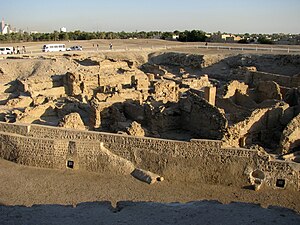Bahrain Fort: Difference between revisions
No edit summary |
m Spelling: Portugese --> Portuguese |
||
| Line 12: | Line 12: | ||
}} |
}} |
||
The '''Bahrain Fort''' (in {{lang-ar|قلعة البحرين}}, [[transliteration]]: '''Qal`at al-Bahrain''', and also known as the '''Fort of Bahrain''' and previously known as the Purtugal Fort '' Qal'at al Pourtugal'' as well as the fort of [[Nader Shah]], the Persian king)<ref name="test">[Axworthy pp.175-274 Link text], additional text.</ref> is an archaeological site located in [[Bahrain]]. It is composed of an artificial mound created by [[human]] inhabitants from 2300 BC up to the 1700's, including |
The '''Bahrain Fort''' (in {{lang-ar|قلعة البحرين}}, [[transliteration]]: '''Qal`at al-Bahrain''', and also known as the '''Fort of Bahrain''' and previously known as the Purtugal Fort '' Qal'at al Pourtugal'' as well as the fort of [[Nader Shah]], the Persian king)<ref name="test">[Axworthy pp.175-274 Link text], additional text.</ref> is an archaeological site located in [[Bahrain]]. It is composed of an artificial mound created by [[human]] inhabitants from 2300 BC up to the 1700's, including Portuguese and Persians. Among other things, it was once the capital of the [[Dilmun]] civilization, and served more recently as a [[Portugal|Portuguese]] [[fort]]. For these reasons, it was inscribed as a [[UNESCO]] [[World Heritage Site]] in 2005. |
||
Qal`at al-Bahrain is a typical [[tell]] – an artificial [[mound]] created by many successive layers of human occupation. The [[stratum|strata]] of the 300x600-metre tell testify to continuous human presence from about 2300 B.C. to the 16th century A.D. About 25% of the site has been [[excavate]]d revealing structures of different types: residential, public, commercial, religious and military. They testify to the importance of the site as a trading port over the centuries. On the top of the 12m high mound, there is the impressive Qal`at al-Burtughal ([[Portugal|Portuguese]] [[Qalat (fortress)|fort]]), which gave the whole site its name, ''qal`a'', meaning fort. The site was the capital of the [[Dilmun]], one of the most important [[ancient civilization]]s of the region. It contains the richest remains inventoried of this civilization, which was hitherto only known from written [[Sumerian language|Sumerian]] references. |
Qal`at al-Bahrain is a typical [[tell]] – an artificial [[mound]] created by many successive layers of human occupation. The [[stratum|strata]] of the 300x600-metre tell testify to continuous human presence from about 2300 B.C. to the 16th century A.D. About 25% of the site has been [[excavate]]d revealing structures of different types: residential, public, commercial, religious and military. They testify to the importance of the site as a trading port over the centuries. On the top of the 12m high mound, there is the impressive Qal`at al-Burtughal ([[Portugal|Portuguese]] [[Qalat (fortress)|fort]]), which gave the whole site its name, ''qal`a'', meaning fort. The site was the capital of the [[Dilmun]], one of the most important [[ancient civilization]]s of the region. It contains the richest remains inventoried of this civilization, which was hitherto only known from written [[Sumerian language|Sumerian]] references. |
||
Revision as of 14:31, 29 August 2010
| UNESCO World Heritage Site | |
|---|---|
 | |
| Criteria | Cultural: ii, iii, iv |
| Reference | 1192 |
| Inscription | 2005 (29th Session) |
The Bahrain Fort (in Arabic: قلعة البحرين, transliteration: Qal`at al-Bahrain, and also known as the Fort of Bahrain and previously known as the Purtugal Fort Qal'at al Pourtugal as well as the fort of Nader Shah, the Persian king)[1] is an archaeological site located in Bahrain. It is composed of an artificial mound created by human inhabitants from 2300 BC up to the 1700's, including Portuguese and Persians. Among other things, it was once the capital of the Dilmun civilization, and served more recently as a Portuguese fort. For these reasons, it was inscribed as a UNESCO World Heritage Site in 2005.
Qal`at al-Bahrain is a typical tell – an artificial mound created by many successive layers of human occupation. The strata of the 300x600-metre tell testify to continuous human presence from about 2300 B.C. to the 16th century A.D. About 25% of the site has been excavated revealing structures of different types: residential, public, commercial, religious and military. They testify to the importance of the site as a trading port over the centuries. On the top of the 12m high mound, there is the impressive Qal`at al-Burtughal (Portuguese fort), which gave the whole site its name, qal`a, meaning fort. The site was the capital of the Dilmun, one of the most important ancient civilizations of the region. It contains the richest remains inventoried of this civilization, which was hitherto only known from written Sumerian references.
Photo gallery
-
Bahrain Fort
-
Bahrain Fort side view
See also
26°14′01″N 50°31′14″E / 26.23361°N 50.52056°E
- ^ [Axworthy pp.175-274 Link text], additional text.
